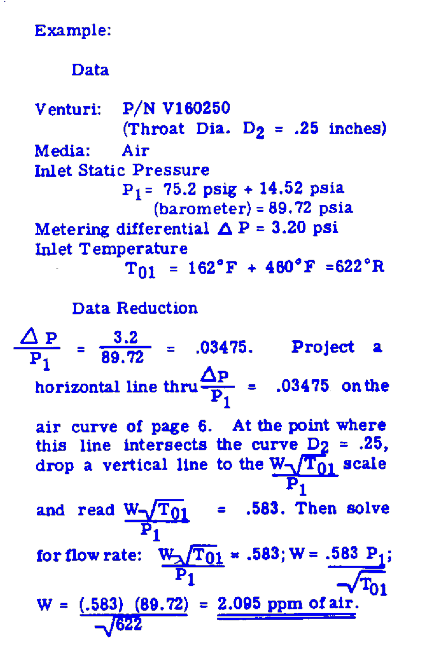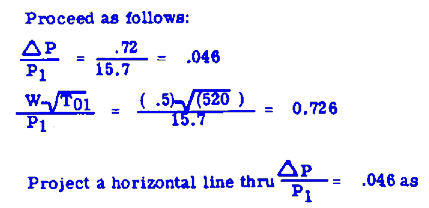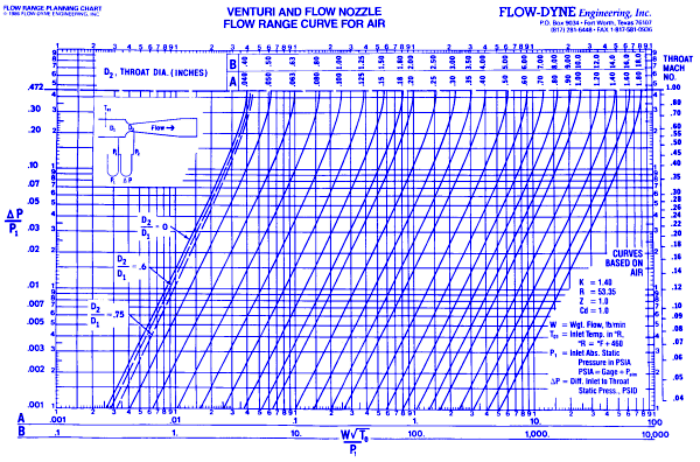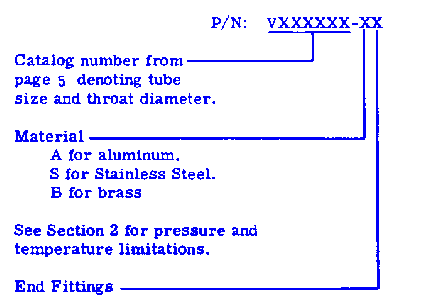

VENTURI FLOW METER
Bulletin 201
The venturi flow meter is installed as a section of pipe or tubing and is used to measure the flow of fluids, either gaseous or liquid. The meter consists of a converging inlet section, a short straight throat section, and a diverging section.
As the fluid enters the converging section, its velocity begins to increase, reaching a maximum value at the throat. The diverging section then slows the fluid to approximately its original value. At the point of maximum velocity, the static pressure has decreased to a value less than the inlet static pressure. The difference between these two pressures along with the inlet pressure and temperature is an extremely accurate and simple indication of the mass rate of flow through the instrument.
Head Loss-
Venturis are designed using a quarter of an ellipse as an inlet approach to the
throat. The exit or diffuser section diverges at an included angle of six (6)
degrees. This combination of internal geometry has been found to provide a
minimum overall total pressure loss in the line due to flow meter installation.
A maximum unrecovered head loss not exceeding 15% of the metering differential
may be expected if throat conditions are sub-sonic.
Specification -
Unrecovered head loss shall not exceed 15% of the metering differential
with sub-sonic throat conditions.
Material (Operating Pressure
and Temperature) -
Flow-Dyne Venturis can be readily supplied in either lightweight aluminum or
rugged stainless steel. Aluminum meters are recommended for operating pressures
of 0 psia to 200.0 psia pressure and minus 65 deg F to plus 260 deg F
temperature. Stainless steel meters are recommended for pressure and temperature
ranges outside that described for aluminum venturis.
Please inquire about higher pressure and temperature combinations.
Specification -
Fabrication material shall be suitable for operation at the pressures and
temperatures specified by the purchaser.
End Fittings -
A variety of end connections can be readily supplied on
all Flow-Dyne venturis. The selection of the most convenient connection is left
to the discretion of the purchaser.
End fittings to fit Standard AN "flared tube" connections are offered for all standard tube sizes from 0.375 inch O.D. to 3.0 inch O.D.
"V" type flanges are offered for all tube sizes 1.00 inch O.D. or larger.
Standard pipe flanges can be supplied or special end fittings can be machined to your specifications.
Specification: The purchaser may specify the type of end fittings desired on each venturi. (All specifications subject to Flow-Dyne price quote.)
Pressure Port Connections - Pressure port connections will normally be drilled and tapped for national pipe threads the size of which may be specified by the purchaser.
Specification -
The size and type of pressure port connections maybe specified by the
purchaser.
Accuracy -
When calibrated and properly installed, the differential pressure produced by
the venturi will yield the actual rate of flow within 0.5%. However, since
secondary instrumentation must be used to measure the pressures and
temperatures, their accuracy tolerance must be added to that of the venturi.
Calibration curves are supplied with each venturi as well as NIST traceable
certification.
Where unrecovered head loss is of importance, calibration curves showing the
actual pressure loss can be readily provided.
Uncalibrated venturis under the same conditions will yield actual flow rates with in plus or minus 3.0%. Theoretical flow curves based on diameter measurements and fluid properties are supplied with uncalibrated meters. Uncalibrated meters can be readily supplied at approximately a 40% cost saving if the decreased accuracy can be tolerated.
Specification -
Calibration -
Venturis which are to be used to measure gaseous flows are calibrated with air
against Flow-Dyne master Sonic Flow Nozzles or volumetric equipment depending on
flow range.
Air calibrations for gaseous flows have the advantage of being valid in the compressible range as well as in the incompressible range. Thus, the meter can be used for valid flow measurements up to the point where sonic velocity occurs at the throat. If the gas to be measured is one other than air, the calibration is converted mathematically.
Similarly liquid calibrations are accomplished with water and the weight-rate method, then converted to the desired fluid.
3. DATA REDUCTION
In using a venturi for measuring flow rates, it is necessary to take 3 measurements pertinent to the flow condition. They are:

4. VENTURI SIZE SELECTION
To aid you in selecting the right venturi for your application, the "Flow Range Curves" are included for your reference. All standard throat sizes are included on these curves.
To properly size a venturi for a particular
application, all of the requirements should be considered. For example, if the
requirements are:

shown on chart.



A - to fit aircraft AN flared tube type connection.
V - for "V" Flange type fittings, Ref: Aeroquip Marman P/N 56400..
C - for "Conoseal" Flanges, Ref: Aeroquip Marman P/N 51132 or 51133 for D2 = 1.00 or larger, P/N 54971 for D2 less than 1.00.
PF - for pipe flanges
PT - for pipe threads (male)
Note:
For pipe flanges or threads, the tube size listed in the catalog automatically
becomes the nominal pipe size. For example, a P/N of V320400-SPF would denote a
stainless steel meter with pipe flanges on both ends sized to fit 2" schedule 40
pipe.
To illustrate the selection of a part number for a venturi of specification:
Tube size: .75 inches O.D.
Throat Dia.: .35 inches
Material: Aluminum
End fittings: To fit aircraft AN flared Tube connections.The part number would be V120350-AA.
If you wish Flow-Dyne to size your venturi(s), send the following information:
Flow-Dyne, Inc.